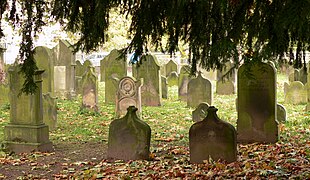Jewish cemetery (Hameln)
The Jewish cemetery in Hameln ( Hameln-Pyrmont district , Lower Saxony ) is a protected cultural monument . There are 173 tombstones for the Jewish deceased from Hamelin and the surrounding area. The oldest gravestone dates from 1741, the youngest from 1936.
history
There was a previous cemetery in Hameln outside the city, which had to give way to the expansion of Hameln in the 17th century to become the state fortress of the Electorate of Hanover . The gravestones were used for the fortress construction in the area of the Münsterkirchhof.
In 1743 the Jewish community purchased a plot of land for a cemetery in front of the Ostertor . It was set in gardens in front of the fortress grounds outside the city. The cemetery is now on Scharnhorststrasse. The officers' and later garrison cemetery in Hameln was laid out near the Jewish cemetery in 1720 . In 1757 the Deisterfriedhof was built in the area. After the Jewish community in Hameln had grown, there was a need to expand the cemetery at the end of the 1870s. To this end, a neighboring piece of garden was acquired, which gave the cemetery its current angular shape and size of around 2100 m². In 1870, the surrounding area was still undeveloped, on which buildings were not built until the turn of the century .
During the Nazi era , burials became more difficult. Craftsmen no longer wanted to make gravestones or coffins for fear of being publicly exposed as “Jewish friends”. During the November pogrom in 1938 , the cemetery was desecrated by overturning and smashing gravestones. The cemetery remained in this state until 1945, when four burials were carried out until 1942. When all the Jews from Hameln were then deported, the Reich Association of Jews in Germany wanted to sell the cemetery property. The city of Hameln offered the low price of around 125 Reichsmarks for this . After the Reichsvereinigung was dissolved in 1943, ownership of the cemetery property was transferred to the Oberfinanzdirektion in Hanover . The leased the site to a Hamelin master stonemason who bought the tombstones for further use. After the war, the city had the cemetery restored in 1946 by the leaseholder as the best expert on the area. Since the damage was great and there was no plan for the cemetery to be occupied, the reconstruction was incomplete. Many broken tombstones were shortened.
Around 1950 the cemetery was returned to the Jewish Trust Corporation and in 1952 it was transferred to the State Association of Jewish Communities of Lower Saxony . In 1963 construction work was carried out on the cemetery because the brick wall was dilapidated. A newly erected fence provided a view of the site for the first time. In 1994 the first new burial took place in the cemetery. At the end of the 1990s, the Jewish community in the Hameln-Pyrmont district took over the maintenance of the cemetery.
See also
literature
- Bernhard Gelderblom : The Jewish cemetery in Hameln . Albert-Einstein-Gymnasium, Hameln 1988 (a project of the Albert-Einstein-Gymnasium in Hameln. Accompanying document to an exhibition that the Albert-Einstein-Gymnasium held on the occasion of the 50th anniversary of the Reichspogromnacht under the title "Traces and Encounters" in the urban Museum).
- Bernhard Gelderblom: Hameln . In: Herbert Obenaus in collaboration with David Bankier and Daniel Fraenkel (eds.): Historical manual of the Jewish communities in Lower Saxony and Bremen . Volume 1 and 2 (1668 pp.). Göttingen 2005, ISBN 3-89244-753-5 , p. 698-720 .
- Bernhard Gelderblom: On the history of the cemetery on Scharnhorstrasse in: The Jews of Hameln from their beginnings in the 13th century to their destruction by the Nazi regime , Holzminden, 2011, pp. 176–295.
Web links
- Hamelin. In: Overview of all projects for the documentation of Jewish grave inscriptions in the area of the Federal Republic of Germany ; here: Lower Saxony
- Bernhard Gelderblom: The Jewish cemetery in Scharnhorststrasse
- Bernhard Gelderblom: The Jewish cemetery in Hameln
- The utilization of the Jewish cemetery in Hameln
Coordinates: 52 ° 6 ′ 21.9 ″ N , 9 ° 21 ′ 59.9 ″ E

